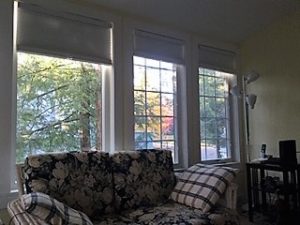Setting: Carolers, Snowmen, Gingerbread? How Do You Know It’s Christmas?
I’ll confess I’m doing something I shouldn’t below.
 The “shouldn’t,” of course? Use this photo, which is blurry and certainly not professional. I snapped it for fun one day in October using my iPad. So what does it say about me and this blog, and why am I including it?
The “shouldn’t,” of course? Use this photo, which is blurry and certainly not professional. I snapped it for fun one day in October using my iPad. So what does it say about me and this blog, and why am I including it?
The Background:
This year we stayed later than usual at Chautauqua Institution in Western NY to enjoy a real autumn. We were surprised at how deserted the grounds were right after the “season” of culture, art, lectures and concerts ended. I was delighted at the silence, which makes writing so much easier, but I did spend a lot of time gazing out my windows.
I was delighted with this particular bank of them and the vibrant reminder of autumn every time I went into our upstairs sun room and settled on my favorite couch. Our cottage is small, and the downstairs was chilly. But the sun room was toasty and flooded with golden sunlight. You can imagine why we spent so much time there as October progressed.
The Windows:
When fall began I noticed immediately that the three windows I gazed out each day told different stories. The two on each end showcase the evergreens growing outside our window (left) and those farther away at a neighbor’s house (right). But the window in the middle? Even though it was only inches from its neighbors, the middle window was a blaze of fall color from trees in the park across the road. Every day I sat and admired it. And every day I thought about the way the places we live, see, hear, and smell change us, especially our attitudes.
The Novel:
When I finally returned home to Florida I bought and read Munich, by Robert Harris. I really like Harris’s writing, and Fatherland, another of his novels, is one of my all time favorites. Munich is set right before WWII, when Neville Chamberlain, Hitler, Mussolini and Daladier, of France, met to affirm that Germany could take back a big chunk of what was then Czechoslovakia, in order to avert (they hoped) another conflict. We all know how that turned out, but this was a surprisingly sympathetic look at what Chamberlain tried to do and why. There’s more to the story, of course, and this is fiction. The two major characters are fictional, too, but the historical events are real.
Today, though, let’s get back to “setting.” I was surprised at how much description Harris used in his novel. I read through pages of description about the inside and outside of buildings, of musty rooms in London government offices and the glittering stone of Hitler’s architecture, of uniforms worn by the Nazis, and banners and revelers in the streets.
The Right Way to Write?
Long descriptions used to be common in novels, drawing the reader into a place, a time period, a character’s world. Try Dickens or Sir Walter Scott, for instance. Am I right?
Now we as authors are advised to choose a word here, a sentence here, to describe the milieu our characters find themselves in, and we school ourselves to let that be enough. Readers want action. They want excitement. They do not want long paragraphs of description.
Not that all novelists listen. While romance writers are often ridiculed for using too much description, I find that mystery authors are the most likely to use copious amounts. In both genres, the book is most enjoyed if the readers feels that he or she is right there with the main character, living his/her life and learning what he/she knows.
Finally, Back To Setting:
So back to my windows. I stayed in NY to experience autumn before I returned to Florida. But if all I knew about autumn were what I saw in my three windows, what could I tell my readers? That autumn is feathery green, patiently waiting for the first snowfall to settle on each curling frond? Or would I describe autumn as a blaze of reds and golds, illuminating the diminishing light and the browns and tans surrounding it until each leaf has fallen? Wouldn’t my description depend on the mood I wanted to convey? All three views, after all, were real.
Robert Harris wanted us to walk government halls, both British and German, to understand the different temperaments and historical moments that each country was experiencing. He accomplished it with dialogue and characterization, but most of all, I think, with setting. He chose which window he wanted to describe and drew his reader into the story by giving them a visual picture. It worked beautifully.
By the way, I miss my windows, although I am absolutely certain not an autumn leaf still clings to the branches of those trees.
Midweek blogging may be hit or miss this month with the holidays. But do watch for Sunday Inspirations each week. And take the time to enjoy your own special setting and all the things we take for granted that make the holidays come alive for each of us, no matter what holidays we choose to celebrate.
Just love your descriptive sentences of the autumn view outside your 3 windows…..that’s why you are an author!!! Enjoy these festive and holiday times. Thanks for sharing your real-life stories.